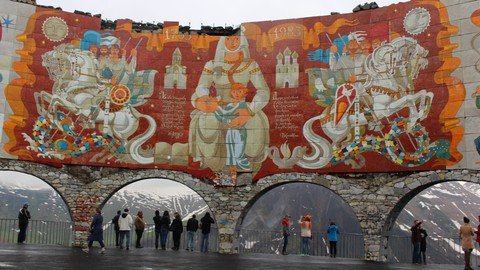The Roots Of Geopolitical Risk: Transcaucasia

Last updated 10/2022
MP4 | Video: h264, 1280x720 | Audio: AAC, 44.1 KHz
Language: English | Size: 2.07 GB | Duration: 1h 48m
The layers of history which led to the current geopolitical hotspots
What you'll learn
Learning the stories of the female leaders who defined Georgia’s religious direction and historical political apex
How both Georgia and Armenia each went from being medieval European empires to Soviet Socialist Republics be
How the Ottoman treatment of Armenians during the First World War period are considered by some as the first modern genocide
Understanding the strategic significance of Azerbaijan’s natural resource wealth (from crucial target in Nazi Germany’s attempt to conquer the Soviet Union, to
Why deadly violence periodically erupts between Armenia and Azerbaijan
Why Russia believes it has something to say about the future direction of the countries in focus here
How international commitments may contribute to the avoidance or potential escalation of conflict
Requirements
None, though an interest in history and diplomacy, and curiosity about the world, helps
The Conflict, Security and Diplomacy series and podcasts on the Living Law® YouTube channel digs deeper into the public international law aspects of relevance
Description
If you are reading this page, you may be curious why there is a new Udemy course focusing on these particular countries. (Or perhaps you landed here by mistake, in which case, please read on nonetheless!). The reason is rather straightforward. Across our planet there are many latent, unresolved, historical conflicts which have become more acute due to recent events. The Russian invasion of Ukraine on Feb. 24th, 2022, shocked many around the world. The boldness of the Russian invasion caused many to begin speculating whether other areas in the broader region might be on the list of the current regime in the Kremlin. A minority of observers was less surprised, seeing this move as the continuation of a long term plan which started with the capture of Crimea in 2014. But exactly what is that long term plan? That is a question which millions around the world have been pondering since the invasion, and the reason behind the creation of this course. Though the war in Urkaine has not gone as well as Russia may have wished, there is no sign of its willingness to abandon its original stated goal: the conquering of Ukrainian territory and the toppling of its current government. The apprehension of the societies in the countries surrounding Russia is thus understandably high. Yet the countries in focus here are not so well known, at least in the West. This course aims to address this issue by tracing the evolution of each country as an independent nation, highlighting their specific historical links to the Soviet Union and current relations with Russia. Our journey begins in Georgia, a country which has deep historical and cultural ties with Russia. Yet despite those ties, Georgia ended up at war with Russia not long after the dissolution of the Soviet Union. The triggering events- disputes over what had been Georgian sovereign territory, combined with subsequent local referenda- bear strange parallels with the recent events in Ukraine. In an ironic twist, at the time of course creation Georgia is a favoured destination for Russians seeking to avoid the recent military conscription. The current events may also impact Georgia's longstanding application to join NATO and have already its political leaders to apply for membership in the European Union. The next country on our journey, Armenia, enjoys relatively good relations with Russia. Like Georgia, Armenia is home to an ancient culture, a unique non-Indo-European language, and a long Christian heritage. Its 20th century history is marred by what Armenians call a genocide at the hands of the Ottomans. We examine the underlying events, focussing on an investigation and report commissioned by the US government at the time. A few years later, Armenia became part of the Soviet Union. When the Soviet Union dissolved, Armenia became independent along with the other nations of Transcaucasia. It also went to war with the nation which marks our third and final stop on this virtual journey: Azerbaijan. The modern territory of Azerbaijan hosted many empires over the years, including the longest-running Islamic dynasty in the region. Like its neighbours, Azerbaijan was also part of the Soviet Union and thus has a long historical relationship with Russia. The discovery of oil transformed the nation in the early 20th century, and natural resources remain the key economic driver. But Azerbaijan's dispute with Armenia over the region of Nagorno-Karabakh periodically erupts into military conflict, contributing to Transcaucasia's reputation for turbulence. Join Living Law® on a tour of this fascinating area of the planet!
Overview
Section 1: Georgia
Lecture 1 Introduction to Georgia
Lecture 2 Russian influence in Georgia
Lecture 3 Georgian influence in the USSR
Lecture 4 Independence, war, and geopolitical realignment
Section 2: Armenia
Lecture 5 Introduction to Armenia
Lecture 6 Successive subjugations of Armenia
Lecture 7 Soviet period and Independence
Section 3: Azerbaijan
Lecture 8 Introduction to Azerbaijan
Lecture 9 Economic and social transformation in the 20th century
Lecture 10 Independence and 21st century direction
businesspersons, educators and students, travellers, professional and armchair diplomats
Screenshots
Homepage
without You and Your Support We Can’t Continue
Thanks for Buying Premium From My Links for Support
Click >>here & Visit My Blog Daily for More Udemy Tutorial. If You Need Update or Links Dead Don't Wait Just Pm Me or Leave Comment at This Post
Download from free file storage
Resolve the captcha to access the links!
Registered members don't get captcha ... just sayin
